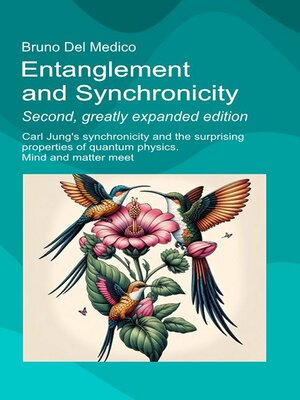Entanglement and Synchronicity. Second, Greatly Expanded Edition.
ebook ∣ Carl Jung's synchronicity and the surprising properties of quantum physics. Mind and matter meet.
By Bruno Del Medico

Sign up to save your library
With an OverDrive account, you can save your favorite libraries for at-a-glance information about availability. Find out more about OverDrive accounts.
Find this title in Libby, the library reading app by OverDrive.



Search for a digital library with this title
Title found at these libraries:
| Library Name | Distance |
|---|---|
| Loading... |
Imagine two particles, separated by kilometers, even light years, capable of influencing each other instantaneously, as if a strange invisible thread connected them through the void. Albert Einstein defined this property of the universe with a hint of skepticism as "spooky action at a distance." It was 1935, and even the most visionary physicists sensed that the idea of entanglement defied all common sense. But it was not a fanciful invention. Far from it, it was a direct consequence of quantum theory, an area of physics that had emerged a few decades earlier among the enlightened scientists of early 20th-century Europe.
Entanglement is at the heart of one of the greatest mysteries of modern physics. However, it brings to mind another concept, much older but equally provocative: Carl Gustav Jung's synchronicity. Jung, a psychiatrist and founder of analytical psychology, described synchronicity as a 'meaningful coincidence', a non-causal link between different events that seem to resonate in a kind of secret harmony. Could we perhaps venture to see quantum entanglement as a surprising scientific echo of Jung's insights?
This book moves between science and philosophy, between empirical data and surprising insights. It offers a reflection that goes beyond the boundaries of the tangible, into fascinating and unexplored territories. The author invites the reader to do what great minds have always known how to do: observe the strangeness of the ordinary to glimpse the extraordinary.
Today, while laboratories provide us with mathematical proof of incredible wonders, our human instinct drives us to ask whether there is something more. Perhaps, as the great physicist David Bohm suspected, there is an implicit order in the universe that we cannot yet fully understand. Bohm suggested that non-locality, a fundamental principle of quantum physics, could be a key to reinterpreting the connection between mind and cosmos.
Almost inevitably, when we talk about quantum entanglement, we enter the realm of metaphysics. Some scholars (or, perhaps, it would be more appropriate to say "some enlightened minds") have glimpsed in quantum fields the basis for explaining extrasensory perceptions. It is a slippery frontier, to be sure, but not without its charms.
It is no coincidence that in many mystical traditions, from East to West, there are references to energy fields that connect all things. Think of the concepts of "prana" in Indian philosophy or "qi" in Chinese philosophy. Quantum physics, in some ways, seems to suggest that such ideas are not just moral poetry, but fragments of a physical truth yet to be deciphered.
In an age when technological disenchantment seems to reign supreme and nothing amazes us anymore, a topic such as entanglement reminds us that mystery has not been erased. The mystery has merely been moved forward: it has passed from myths and legends to laboratory experiments. Perhaps this is because, as quantum entanglement suggests, there is no longer a "here" and a "there," a "before" and an "after." Perhaps everything is connected. And in this connection, perhaps, we can rediscover the wonder we had lost.







